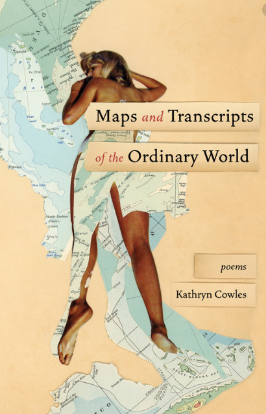Review: Maps and Transcripts of the Ordinary World
Posted on August 9, 2020
PromptPress Editor Nina Lohman reviews Kathryn Cowles' poetry collection Maps and Transcripts of the Ordinary World
In college, my first declared major was Geography. I chose it because I was curious to know how interacting with the world through landscapes and neighborhoods influenced life and, subsequently, the stories we tell.
But mostly, I was, always have been, and still very much am, enamored with maps. Call forth stories, yes, but let my days be consumed by boundaries and curves and water and relief.
Maps are stories. They portray how we shape, interact with, and label the earth. Kathryn Cowles’ Maps and Transcripts of the Ordinary World does this, too.

Using the complement of image and word, Cowles focuses on the exercise of capturing the lived world. But what is most compelling about this collection is what Cowles chooses to capture, what she holds cupped in her hands for you to see. Cowles’ aim is not to describe the view from the top of the Greek island, rather it is to lay bare the effort it takes to grip a living moment; a tangible landscape.
I take seven photographs turning
in a circle, a panorama,
but how will I place them hanging
on a wall back home? Something is already slipping.
This feels familiar. I know I can’t press pause and yet I try to anyway and yet I do so knowing I will fail. Maybe it’s the urge to hold tight to the moment I relate to most in this collection. I notice in Cowles’ poems, and in my life as well, the instinct to turn a moment over and over searching for a purchase.
I am always on this porch wrapped in a blanket.
There is always at least some wind. Picture this. The invisible wind. Its evidences. The wind can blow so hard that whole dogs blow over. I am always looking. I have tried to write it down. The ordinary world. When I
did, and when I didn't, it was always still there.
How do you grasp a living thing? How do you transcribe the world in a way that makes sense? For Cowles, it is done through recipes, lists, field guides, and marginalia. Cataloging the world in this way allows Cowles to tenderly put down on the page the experience of the ordinary.
I want to commit it to memory. I want to commit it to memory. The photographs slip in place of memory, metaphors for the actual landscape. Transubstantiation. Out of my hands. I sit and watch.
I have always been impressed when artists are able to accurately portray the ordinary. Nuance demands certainty whereas conventionality allows ambiguity. I think of Ordinary Women and The Assistant and how in these films, tremendously complex stories are conveyed through the brilliant subtleties of everyday life. Maps and Transcripts of the Ordinary World compels the reader to attend to the business of the everyday. This is no small feat.
Cowles pairs the poems in this collection with a series of black and white photographs overlaid with cutout, typed words and phrases. It’s what mapmaking is fundamentally all about: visual documentation layered with descriptive words. Though the practice is similar, the effect is different. Cartography tends to be soothing, soft. Clear. By contrast, these images are somewhat jarring. Looking at them I felt a bit confused. Through these images, Cowles highlights the competition between image and word. This is not a criticism, it is a revelation to expose a new way of seeing the familiar. Maps have always been visual transcriptions of the world. It took this collection for me to see it that way.
Maps and Transcripts of the Ordinary World doesn’t stay in one place. It takes the reader to Greece, across the ocean, to the past, to Ohio. Each poem, and the collection as a whole, lands the reader in a solid place. The experience of this collection is a bit like when you consult a map to take you to the place you want to go and then suddenly, after all the twists and turns, realizing you have arrived.
Looking up. A scope. A miniature. And I was there. And I breathed the original air.
Purchase Maps and Transcripts of the Ordinary World and read more about Kathryn Cowles.